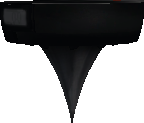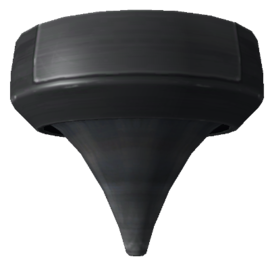T-1 Toroidal Aerospike "Dart" Liquid Fuel Engine
| T-1 Toroidal Aerospike "Dart" Liquid Fuel Engine | ||
| Liquid fuel engine by C7 Aerospace Division | ||
| Radial size | Radial mounted, Small | |
| Cost | (total) | 3 850.00 |
| Mass | (total) | 1.000 t |
| Drag | 0.2 | |
| Max. Temp. | 2000 K | |
| Impact Tolerance | 20 m/s | |
| Research | | |
| Unlock cost | 24 500 | |
| Since version | 0.15 | |
| Part configuration | liquidEngineAerospike.cfg | |
| Maximum thrust | (1 atm) | 153.53 kN |
| (vacuum) | 180.00 kN | |
| Isp | (1 atm) | 290 s |
| (vacuum) | 340 s | |
| Fuel consumption | 10.80 | |
| Thrust vectoring | No | |
| Electricity generated | 5.0 ⚡/s | |
| Testing Environments | ||
| On the surface | Yes | |
| In the ocean | Yes | |
| On the launchpad | Yes | |
| In the atmosphere | Yes | |
| Sub-orbital | Yes | |
| In an orbit | Yes | |
| On an escape | Yes | |
| Docked | No | |
| Test by staging | Yes | |
| Manually testable | Yes | |
| Packed volume | 1600 l | |
The Toroidal Aerospike "Dart" Liquid Fuel Engine is a liquid fuel engine with the unique feature of being almost the most efficient at any atmospheric pressure.
Contents
Usage
The aerospike rocket is an unusual rocket engine with good thrust-to-weight ratio, and relatively high fuel efficiency. Thanks to its unique nozzle, it is almost equally effective at all altitudes, unlike other engines. It does not have any thrust vectoring. Despite this drawback, it is still usually one of the best choices for an engine when building spaceplanes.
An added advantage in this application is that aerospikes are also quite short, which can help reduce the risk of collision with the runway during takeoff when the engine is mounted at the rear of a spaceplane. Another advantage is that the short length makes it a good alternative for the LV-909 Liquid Fuel Engine on landers, when more thrust is required or the landing takes place in an atmosphere, though it is heavier than the LV-909.
Product description
| “ | The Toroidal Aerospike is a huge breakthrough from C7 Aerospace. While heavier than previous models, with its heavy-duty exhaust nozzle, the Aerospike makes up for it with an efficient burning of fuel at all altitudes. — C7 Aerospace Division |
” |
Trivia
- In real life, the heavy aerospike nozzle is an advanced alternative to the classic hourglass-shaped De Laval nozzles sported by the LVT engines. The bell of a rocket nozzle contains and accelerates the supersonic exhaust gas, converting exhaust pressure into velocity along its length. The longer the nozzle, the lower the final pressure becomes. However, in an atmosphere, the exhaust stream interacts with the air around it, and if its pressure falls too low in comparison the stream can become unstable and inefficient. In a vacuum, an ideal nozzle has an infinite length, but practically nozzle length is a tradeoff - shorter nozzles can handle thicker atmosphere, but don't generate the exhaust velocity of longer ones. A Conical Aerospike shape provides comparable performance to a De Laval nozzle in space, but at lower altitudes, it can be 20-30% more efficient.
- In versions 0.15, and 0.16, the aerospike had the highest Isp of any stock engine. In versions 0.16 and 0.17, the aerospike had the highest TWR of any stock liquid fuel engine. As a result of these features, it benefited more from the throttle bug than any other engine. Between versions 0.18 and 0.21.1, a large chunk of the part.cfg was missing, resulting in the aerospike having default drag, max temp, and impact tolerance. This caused odd behavior under some circumstances.
- The engine's name of “T-1 Toroidal Aerospike “Dart” Liquid Fuel Engine” is derived from its real world inspiration—the toroidal aerospike engine flown on the Dryden Aerospike Rocket Test. It differs from linear aerospike engines in that the exhaust is emitted in a ring (torus) around a single spike, rather than in a rectangular fashion around an elongated wedge. Interestingly enough, the D.A.R.T. flight was powered by a solid rocket booster, while Kerbal Space Program's aerospike can only burn liquid fuel and oxidizer.
Changes

- Remodeled and retextured
- Now it can be stacked above other parts
- Mass reduced from 1.5 to 1.0
- New description
- Missing part.cfg lines restored: drag is now 0.2, impact tolerance is now 20 m/s, and maximum temperature is now 3600 K.
- Alternator added, engine now generates 5.0 electric charge per second.
- cost increased from 850 to 3850
- Part now uses fuel and oxidizer. Thrust reduced (250 -> 175), Sea level Isp reduced (390 -> 388), mass increased (1 -> 1.5)
- (Accidental) drag value (0.2) removed, defaults to 0.1
- (Accidental) impact tolerance value (20) removed, defaults to 9
- (Accidental) maximum temperature value (3600) removed, defaults to 3400
- Changed part type from LiquidEngine (mass 2.5, thrust 225, fuel consumption 7.6) to LiquidFuelEngine (mass 1, thrust 250, Isp 390)
- Initial Release
